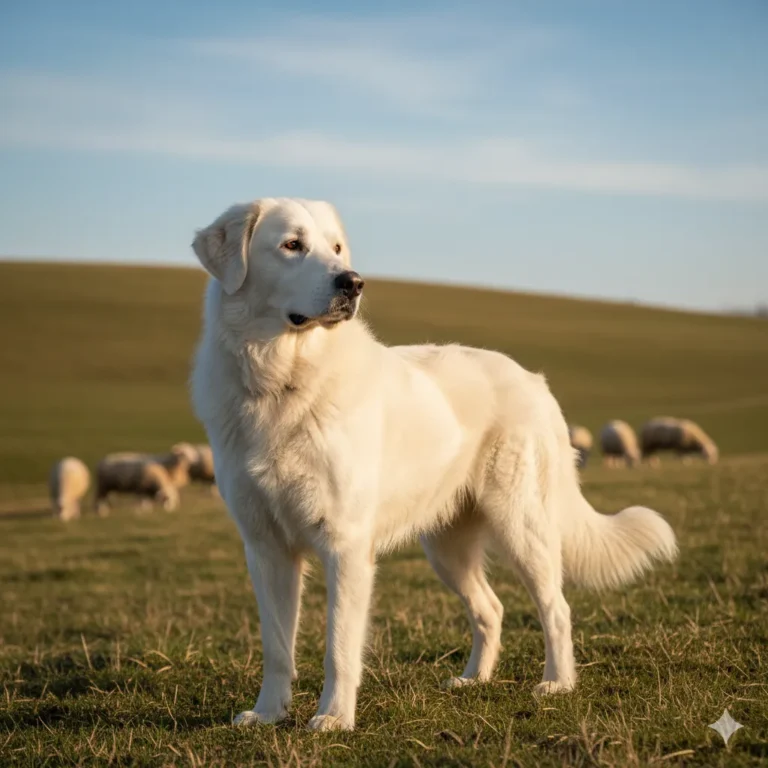
Author: DogsBlogSS Team
⚠️ Disclaimer: This article is for informational purposes only and is not a substitute for consulting a veterinarian.
maremma sheepdog dogs
If you’ve ever imagined a majestic white dog standing guard in the countryside, gently but firmly keeping watch, meet the maremma sheepdog dogs—strong, loyal, and full of purpose. These dogs aren’t just pretty faces; they carry centuries of tradition, instinct and heart — making them fascinating companions for the right person. Over the next sections, we’ll look at what this breed is all about, how they behave, what they require, and whether they might be the match for your life.
I. Understanding the Breed & Its Purpose
What is a Maremma Sheepdog?
The breed we know as the maremma sheepdog dogs (also called Maremma Sheepdog) are large, white-coated livestock guardian dogs originally from Italy. (According to Wikipedia)
According to the UK breeding authority The Kennel Club, these dogs were mentioned in Roman times and given their characteristic white coat and size to work alongside shepherds.
What is the primary purpose or origin of the Maremma Sheepdog?
The roots of these dogs trace back to the Maremma region of Tuscany and the nearby Abruzzo region of Italy. (According to Wikipedia) Their key role: guarding flocks of sheep from predators, staying with the herd, alerting to danger, and even confronting wolves or bears in mountainous terrain. (According to grandedaze.com) Over time, this heritage gave them a unique set of instincts and behaviours.
Are Maremma Sheepdogs good family pets?
In short: they can be, but they are not for everyone. Their history as working guardians means they have strong protective instincts and need space, purpose and consistent leadership. A family environment can suit them—especially if you’re active, live in a rural or semi-rural setting and understand their needs. They may not be ideal for someone expecting a low-maintenance couch-companion.
What are the key characteristics that define the Maremma Sheepdog breed?
Here are some traits you’ll often see:
- A large, solid build and a thick white double coat (helps them weather cold mountain nights and hot summers) (According to caninemaster.com)
- Independent thinking: they’re bred to make decisions while guarding flocks, not waiting for each command. (According tocaninemaster.com)
- Calm dignity and loyalty: they bond with the flock (or family) and tend to work quietly rather than hyperactively. (According to Abruzzo Maremma Sheepdog Breeder)
- A strong guarding instinct—though ideally channelled appropriately.
Is the Maremma Sheepdog the right breed for me?
Ask yourself:
- Do I have enough space (large yard, acreage, or rural environment)?
- Can I give this dog meaningful work or purpose (even if it’s just regular patrols/play outside rather than actual sheep guarding)?
- Am I confident at being a consistent, calm leader (since these dogs respond best to trust and respect, not force)?
- Am I okay with a breed that may not always be the easiest in standard obedience-classes, and which might require adjustment of typical pet-dog expectations?
If you answered yes to those, then yes—they might be a great match. If you live in a tiny apartment, rarely outside, or expect a dog to never wander or guard, you might want to consider a different breed.
II. Temperament & Behavior
What is the typical temperament of a Maremma Sheepdog?
The typical temperament of a Maremma Sheepdog is steady, reserved, dignified and independent. They’re not overly flashy or attention-seeking like some extroverted breeds. According to articles, “gentle giants” is used to describe them. (According to fennerschool.anu.edu.au) They’re observant rather than constantly in your face, and they often prefer to be on the edge of events rather than at the center.
Are Maremma Sheepdogs aggressive?
Not inherently aggressive—but they are protective. Their guardian instinct means they’ll stand up for their “flock” (which could be your family, your animals, or your home) if they perceive a threat. Importantly, aggression is not their default mode—they’re bred for deterrence and presence more than for aggression. That said, without proper leadership, training and socialisation, any large guardian breed can develop unwanted behaviours, so care is required.
How do Maremma Sheepdogs interact with children and other pets?
With proper socialisation, they often do well with children and other pets—especially smaller animals like chickens, goats or sheep, because historically they were raised with flocks and thus learned to treat them as part of the pack. (According to caninemaster.com) However:
- With children: you’ll still want supervision, because the dog’s large size and guardian instincts may lead it to treat play or unfamiliar behaviour as something to manage rather than join in.
- With other dogs: generally fine, especially if raised together, but strong personality means they prefer to know their hierarchy and environment.
- With other pets: yes, they can be comfortable with many kinds of animals—but the individual dog’s upbringing, socialisation and early exposure matter a lot.
Are they prone to barking?
They are not known to be excessive barkers compared to other types of livestock guardian or farm breeds. For instance, one blog noted: “They are also not as big of barkers like the other livestock breeds.” (According to caninemaster.com) That doesn’t mean zero barking—if they sense something off, you’ll hear it. But they’re more likely to observe first than to constantly fuss.
Do Maremma Sheepdogs wander or have a strong prey drive?
This deserves careful attention. On the plus side: they are less likely to wander or bolt compared to many other working breeds—because their instinct is to stay with the flock/pack rather than roam. (According to caninemaster.com) On the flip side: their prey drive is moderate—they’re not primarily bred to chase, but they do protect. Their guarding instinct can make them wary of unfamiliar animals or intruders. So you’ll want secure fencing and good recall if you allow off-lead time.
III. Care, Training & Exercise
How much exercise does a Maremma Sheepdog need?
Given their heritage and size, they benefit from more than 2 hours of activity per day—this aligns with the recommendation from The Kennel Club for large pastoral breeds. (According to thekennelclub.org.uk) They don’t just need a lap around the block; ideally, they have space to wander, patrol, sniff, explore. If you keep them in a fenced yard where they can move freely, that helps. Walks, hikes, and purposeful activity make them happy.
Are Maremma Sheepdogs easy to train?
“Easy” might be the wrong word—trainable, yes, but this is a breed that thinks for itself. One trainer said: “You cannot train these dogs using fear and intimidation… you’ll have to change some of your normal and natural actions.” (According to caninemaster.com) What this means: you’ll get far better results with positive reinforcement, consistency, leadership and clear boundaries than with heavy-handed methods. Because the dog has independent thinking, you’ll need patience.
What is the best way to train a Maremma Sheepdog?
Here are some key training tips:
- Start early: puppy socialisation is critical so each new person, pet, environment becomes familiar under calm supervision.
- Be consistent but gentle: use positive reinforcement (treats, praise, play) rather than punishment.
- Build leadership: not domineering, but consistent rules, boundaries, and clear communication so the dog knows its place and role.
- Provide mental stimulation: guarding breeds benefit from tasks, challenges, interactive play or training games.
- Respect the breed’s instincts: for example, if you allow them to roam off-lead, make sure they’re reliable with recall and feel safe staying near you rather than wondering.
- Understand environment: if you bring a dog bred for outdoor guardian duty into a small apartment, you’ll be fighting an uphill battle.
Do they require a lot of space?
Yes—space helps. Large garden, rural or semi-rural setting is a much better fit than a tiny urban dwelling. The Kennel Club summarises that the Maremma is a large breed, “Size of home: large house” and “Town or country: Country”. (According to thekennelclub.org.uk) They don’t have to be in the countryside, but you must provide space and build their environment accordingly.
What kind of environment is best for a Maremma Sheepdog?
The ideal environment for a Maremma Sheepdog is:
- A home with a large securely fenced yard or acreage, where the dog can move freely.
- Family or setting where the dog will spend significant time outdoors, with access to patrol/roam, rather than locked inside all day.
- Structured setting with consistent daily routine, socialisation, and leadership.
- If there are other animals (sheep, goats, chickens, other pets) the dog should have early positive exposure and clear boundaries.
- Good fencing and safety measures—these are large dogs, and if their protective instincts trigger they may test boundaries.
IV. Health & Lifespan
What is the average lifespan of a Maremma Sheepdog?
According to the Kennel Club, their lifespan is generally over 10 years for the breed. (According to thekennelclub.org.uk) However, older sources (for example the Wikipedia page on the Maremmano-Abruzzese) mention median age at death as 7.5 years in one study. (According to Wikipedia) The discrepancy highlights that lifespan depends greatly on genetics, environment, diet and care. With good care, many can reach 10–12 years or more.
Are Maremma Sheepdogs prone to any specific health issues?
Yes, as with all breeds, there are a few health considerations to be aware of:
- Hip dysplasia: The Kennel Club notes this is one of the conformational concerns for the breed. (According to thekennelclub.org.uk)
- Joint issues: Because of their large size and active rôle, joints may be under strain if overweight or not exercised properly.
- Coat/skin issues: Their double coat needs proper maintenance; mats or skin infections can occur if neglected.
- Other general large-breed risks: bloat (gastric torsion), heart issues—so ensure your breeder screens appropriately and you monitor health. Responsible breeders will offer pre-breeding health checks. (According to thekennelclub.org.uk)
What should I know about their dietary needs?
Because they’re large and active dogs, their diet needs quality and balance:
- High-quality dog food formulated for large breeds, with appropriate protein, healthy fats and joint support nutrients (glucosamine/chondroitin) if advised by your vet.
- Monitor weight carefully—overweight dogs suffer more joint issues, mobility problems.
- Consider life-stage diet: Puppies, adults, seniors all have differing needs. A rapidly growing large-breed puppy needs careful feeding to avoid growth-plate issues.
- Provide fresh water, account for seasonal changes (coat might get thicker in winter, may burn more calories).
- Consult your vet about specific needs—there’s no one-size-fits-all.
related: Bland Diet for Dogs with Diarrhea or Colitis & pancreatitis
How often should a Maremma Sheepdog be groomed?
Their thick double coat means grooming is important. According to The Kennel Club listing: grooming frequency for the breed is “More than once a week”. (According to thekennelclub.org.uk) So:
- Brush at least 2–3 times per week, more during seasonal coat changes.
- Check for mats, especially behind ears, around neck and under belly.
- Bathe only as needed (they often are outdoors a lot, so frequent baths could strip protective oils).
- Regular check of ears, nails, teeth as with any dog.
- Seasonal shedding: expect heavier shed when coat changes—so be prepared for more work during those times.
V. Owning a Maremma Sheepdog: Practical Considerations
How much does a Maremma Sheepdog puppy cost?
Prices vary widely based on country, breeder, lineage, health testing and location. Because the maremma sheepdog dogs are less common in some regions, expect to pay more than average. Always ensure the breeder is reputable, health-tests are done, and you’re buying a puppy with proper documentation. Also budget for lifelong costs: food, vet care, grooming, fencing/security.
Where can I find a reputable Maremma Sheepdog breeder or rescue?
Here are some suggestions:
- Look for breed clubs: In the UK for example, the Kennel Club provides a “Find a Puppy” service for the breed. (According to thekennelclub.org.uk)
- Seek breeders who provide health testing, show a track record of good temperament, socialisation and are open about lineage. One such breeder: Kim Crawmer (who raises and trains Maremmas and is part of the breed club in the US) noted she has been working with the breed since 2016. (According to prancingponyfarm.com)
- Consider rescue options: Some working-dog rescues may have maremmas needing homes; always ask about the dog’s history, temperament and needs.
- Visit the kennel/facility if possible: ensure dogs are cared for, socialised, healthy, the environment is clean, and the breeder asks you the right questions (they should ensure you’re right match for the dog).
- Avoid breeders who have many breeds, lack transparency, or who prioritise volume over suitability.
What are the challenges of owning a Maremma Sheepdog?
Some of the realistic challenges:
- Space requirement: Not ideal for small apartments or homes without outdoor access.
- Strong guardian instinct: Without proper leadership and channelled purpose, some behaviours (territoriality, independent decisions) may surface.
- Training needs: They may not respond like standard obedience-dogs; you’ll want to adapt your expectations and training style.
- Grooming and maintenance: Thick coat, seasonal shedding, outdoor dirt.
- Socialisation: You’ll need to invest early in exposing the dog to children, other animals, guests, so that guarding instincts don’t become over-zealous.
- Long-term commitment: Large breed = bigger costs (food, vet, repairs, fencing).
- Potential mismatches: If you expect a mellow couch-potato lap dog, you may be frustrated. This breed expects work, freedom, meaningful outdoor life.
Do Maremma Sheepdogs shed a lot?
Yes—they do shed, particularly seasonally when their thick double coat changes. The grooming frequency recommendation (more than once a week) reflects that. (According to thekennelclub.org.uk) If you live in a home with vacuuming or allergy sensitivities, prepare accordingly. Their white coat does highlight dust and dirt more obviously than darker coats.
Conclusion
In the end, the maremma sheepdog dogs are remarkable animals: built over centuries to guard, protect and serve in rough environments; loyal yet independent; serene yet alert. They can bring tremendous joy and purpose to the right person or family—especially if you appreciate their strengths and are ready for the responsibilities. But they’re not a plug-and-play pet. If you’re drawn to their history and want a working-mind dog with heart, they could be a perfect match. If your lifestyle is more downtown, low-maintenance or minimal outdoor space, you might be better served by a less demanding breed. Either way, choosing any dog thoughtfully means honouring both your needs and the dog’s.
Here’s to making a match that honours both.
Useful Expert Links
- The Kennel Club – Breed profile: Maremma Sheepdog: https://www.thekennelclub.org.uk/search/breeds-a-to-z/breeds/pastoral/maremma-sheepdog/ (thekennelclub.org.uk)
- Kim Crawmer, breeder/trainer working with Maremmas: https://www.prancingponyfarm.com/kim-crawmer—maremma-breeder–trainer.html (prancingponyfarm.com)
- https://www.caninemaster.com/blog/enter-the-maremma (caninemaster.com)
Notice : The DogsBlogSS editorial team is dedicated to providing accurate, research-based information about dog health, behavior, and care. All our articles are fact-checked using trusted veterinary sources such as VCA Hospitals, Merck Vet Manual, and the AKC.
you may like it







